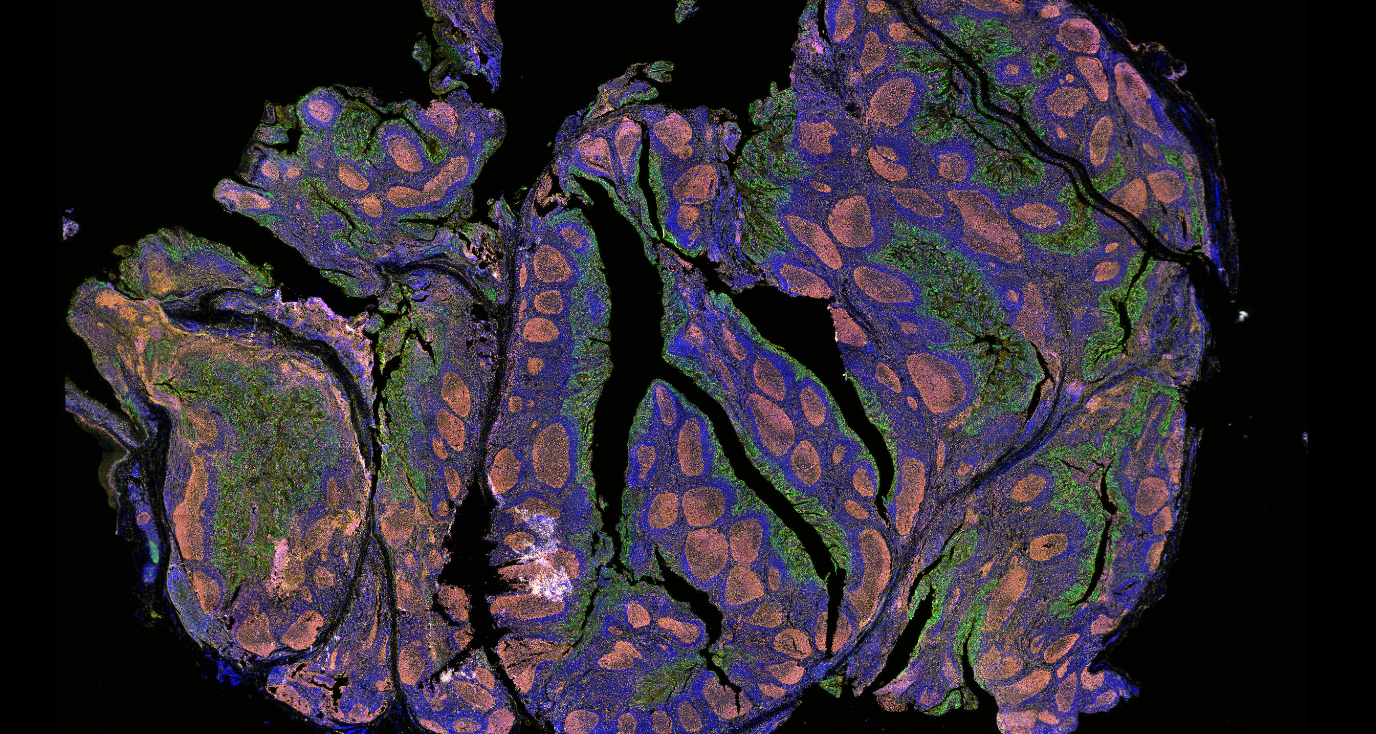The physical size of pixels on the sensor is a very important camera specification. Here, pixel size is defined as the size in ‘x and y’ (i.e., parallel to the sensor itself) of the repeating unit in the grid of pixels. This is also known as ‘pixel pitch’. The actual width of the light-sensitive part of the pixel, or the physical depth of the pixel into the sensor, are both accounted for in other specifications, not the pixel size.
Figure 1: Definition of pixel size
Camera pixel size in x and y is defined by the size of the repeating unit on the grid of camera pixels, and not by the physical size of any pixel component (e.g., microlenses).
As manufacturing processes for sensors have improved, pixels have miniaturized.
This is highly desirable for consumer cameras and mobile phone cameras, where smaller sensor area reduces sensor cost. However, for these cameras it’s unlikely the user will ever know the pixel size, which likely won’t be displayed in camera specifications. So why is pixel size important in scientific imaging?
For scientific imaging, smaller is not always better. There are two significant factors that the pixel size influences: the ability of the camera to resolve fine details, and the sensitivity of the camera through its ability to effectively capture photons. An over-simplified rule of thumb is that the smaller your pixel, the more detail you can capture in your image, but the less sensitive your camera will be.
The Role of Pixel Size in Microscopy
Pixel size refers to the physical dimensions of the individual sensors that make up the image. These sensors collect photons from the light passing through or reflected by the sample being imaged. In digital imaging systems, the number of pixels on a sensor and their size determine how much light can be collected and how finely the image is captured.
The pixel size of a camera or detector in a microscope directly influences its performance. Smaller pixels have a higher density on the sensor, leading to finer image details and better resolution. However, they also have smaller areas to capture light, which can reduce the overall sensitivity of the system. Larger pixels, on the other hand, have more surface area to collect photons, but may sacrifice resolution for light sensitivity.
When it comes to light collection, the size of the pixel dictates how much light the detector can capture at any given time, which influences the brightness and clarity of the resulting image. The larger the pixel, the more photons it can collect, which can improve the image's overall quality, particularly in low-light environments.
Collecting More Photons with Larger Pixel Area
Which would you rather use to collect rainwater: a bucket or a tea cup? The larger our pixel area, the more photons it will capture.
Camera photon collection is directly proportional to the pixel area, meaning when comparing a camera to another with twice the pixel size, the pixel area and hence the light collecting ability will be four times larger for the larger-pixel camera. Should quantum efficiency and other factors remain the same, the smaller-pixel camera would require four times longer exposure or four times brighter imaging subject to equal the detected signal of the larger pixel camera.
Another factor is field of view. For the same number of pixels, larger pixels would cover a larger area of the imaging subject (providing the optical system is capable of
delivering this field of view).
A final consideration is that larger camera pixels can have a physically larger area in which to store collected photoelectrons during the exposure of an image. The maximum number of photoelectrons that can be stored, called the Full Well Capacity, can then be higher, allowing brighter signals to be captured.
Figure 2: Typical camera pixel sizes, larger pixel areas capture more photons
From left to right, pixel size for a typical smartphone camera (1.2 μm), a small-pixel documentation camera (2.4 μm), a typical sCMOS for medium magnification microscope objectives (6.5 μm), and a large pixel sCMOS for high magnifications or high-sensitivity applications (11 μm). Light collection ability is proportional to pixel area.
Object Space Pixel Size and Its Importance
However, there is a very important point to consider: from the perspective of light collection ability, resolution, and field of view, it is the final ‘object space pixel size’ that is important, also called the ‘image scale’. This refers to how much of the imaging subject is viewed by each pixel of the image the camera produces.
For a given optical system, changing between two different cameras with different pixel sizes would lead to light collection ability and resolution changing. However, if magnification could be changed without affecting light collection or throughput such that the object space pixel size between the two cameras is the same, the light collection ability, field of view, and resolving power would be the same.
For most microscopes and lens-based systems, however, a decrease in magnification (causing an increase in object space pixel size) is often accompanied by a reduction in Numerical Aperture (for microscopes) or lens aperture size (for lenses) that can significantly reduce the light collection ability of the optical system.
Why Pixel Size Matters for Light Collection
If you have two cameras with the same overall sensor size but different pixel sizes, in a given optical system the same number of photons would land on both of these sensors. So why does the pixel area matter?
At the heart of any discussion on pixel size in microscopy is the crucial relationship between pixel size and light collection efficiency. Simply put, pixel size directly influences how well a microscope can collect light and convert that light into usable information. Larger pixels have more surface area to gather photons, resulting in better light collection. This leads to clearer, more detailed images, particularly in dimly lit samples.
On the other hand, smaller pixels capture fewer photons because of their reduced surface area. As a result, they may produce images with lower contrast and higher noise, especially when light is scarce. Smaller pixels can also lead to a lower signal-to-noise ratio (SNR), which can degrade image quality. For microscopy applications requiring the detection of weak signals—such as in live-cell imaging or low-light fluorescence imaging—larger pixels can significantly improve the quality of the resulting image.
For instance, fluorescence microscopy typically requires higher sensitivity to detect faint signals from fluorescently labeled specimens. In these cases, larger pixels are preferred as they capture more photons, leading to clearer and brighter images of weak fluorescence signals without needing to increase exposure times or light intensity. This is especially important when studying dynamic biological processes in living cells, where too much light exposure could damage the sample.

In confocal microscopy, the need for both resolution and light collection is balanced. While smaller pixels can offer higher resolution and finer details, larger pixels are often necessary when imaging thicker specimens or during live-cell imaging, where light sensitivity is more crucial. The larger pixels help in collecting more photons from different focal planes, providing better images at deeper layers without excessive exposure, which could lead to photobleaching.
Larger pixels also have an improved dynamic range, allowing them to capture a broader range of light intensities without saturating. This is especially beneficial in imaging samples that have areas with varying light intensities. With a larger pixel size, the sensor can capture both bright and faint regions in the same image without losing detail in either.
The Trade-Off Between Pixel Size, Resolution, and Light Collection
When selecting the optimal pixel size for microscopy, there is an inherent trade-off between resolution and light collection. Smaller pixels provide higher resolution, as more pixels are packed into the same area, leading to finer details. However, the downside is that smaller pixels have less surface area to collect light, which can result in lower sensitivity and higher noise.
Larger pixels, on the other hand, improve light collection efficiency and can enhance the image's brightness and contrast, especially in low-light situations. However, the trade-off is a reduction in resolution, as fewer pixels are available to capture the fine details of the sample.
The optimal pixel size depends on the specific application and the type of microscopy being used. For example, in high-resolution imaging applications like electron microscopy, smaller pixels are typically preferred to capture fine details. However, in applications where light sensitivity is more critical, such as fluorescence or live-cell imaging, larger pixels are often the better choice.
Selecting Pixel Sizes for Specific Microscopy Techniques
Researchers must consider the unique needs of their application:
● Fluorescence Microscopy: Larger pixels are often favored due to their superior photon collection capabilities, which is crucial for detecting weak fluorescence signals in low-light conditions. This ensures brighter and clearer images of fluorescently labeled samples without the need for excessive exposure times.
● Confocal Microscopy: A balance between pixel size and resolution is critical. While smaller pixels can provide higher resolution for imaging fine structures, larger pixels may be preferred in instances where increased sensitivity is needed for weak signals, such as in live-cell imaging.
● Electron Microscopy: In high-resolution imaging, smaller pixels are typically used to capture finer details at very high magnifications. However, if the imaging requires capturing more light in low contrast or darker specimens, larger pixels may be more effective.
By considering the specific goals of their microscopy technique—whether that’s maximizing resolution, improving light sensitivity, or achieving optimal signal-to-noise ratios—researchers can optimize pixel size selection to ensure they achieve the best possible results for their investigations.
Conclusion
Pixel size plays a pivotal role in light collection for microscopy, affecting both the sensitivity and resolution of the images captured. Larger pixels excel at collecting more light, making them ideal for low-light environments and enhancing the signal-to-noise ratio. However, this comes with a trade-off, as larger pixels can reduce the resolution, limiting the ability to capture fine details.
In contrast, smaller pixels can achieve higher resolution by capturing finer details, but they tend to be less sensitive to light, which can result in noisier images, especially in low-light conditions. Therefore, selecting the right pixel size requires a careful balance, and understanding the specific demands of each microscopy technique is crucial.
Ultimately, the key to successful microscopy lies in selecting the optimal pixel size for your specific application. By considering the factors that influence light sensitivity, resolution, and image quality, researchers can tailor their approach to ensure they achieve the best possible results in their scientific investigations. Whether maximizing light collection for fluorescence microscopy or ensuring fine resolution in electron microscopy, pixel size is a critical element in the quest for clearer, more accurate images.
Want to explore which microscopy cameras are best for your research? Contact us to learn more about our high-performance microscopy cameras.
Tucsen Photonics Co., Ltd. All rights reserved. When citing, please acknowledge the source: www.tucsen.com


 2025/10/10
2025/10/10







